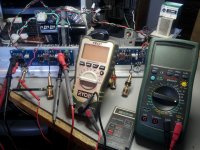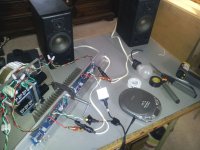Ok I think Iv'e realised how insane my idea was now lol
What would you guys say about EMI filters and the F5 ?
good idea to add one ? if so which.
and please one question id love to know, which additions did you make or even subtractions to the original F5 and PSU that you think are worth doing
What would you guys say about EMI filters and the F5 ?
good idea to add one ? if so which.
and please one question id love to know, which additions did you make or even subtractions to the original F5 and PSU that you think are worth doing
Ok I think Iv'e realised how insane my idea was now lol
What would you guys say about EMI filters and the F5 ?
good idea to add one ? if so which.
and please one question id love to know, which additions did you make or even subtractions to the original F5 and PSU that you think are worth doing
If there is a simple answer to this question, somebody would have already posted it. Lot of people have made lot of mods and depending on who you talk to, you will get different answers. However, I would encourage others to speak up...I built the stock amp (IRF outputs) and the stock PS and it sounds great with CJ PV-14 tube pre-amp as well as with a solid state PassLabs X2.5 pre-amp. Speakers are large volume Goodmans Axioms @~92dB. My only problem is I need more power and this is where all the fun begins, because there are various ways to do it...Reading few previous posts about larger filter caps, it never ever occurred to me to add more C for better filtering, since my stock PS is dead silent.
Thanks, we have added RF filtering now in the IEC
Thanks Rade95. yes will be adding a bit more than the original PSU capacitance.
Iv'e been thinking about something, is it possible to have a variable resistor with the original feedback resistor so to be able to vary the amount of feedback of the amp ? i like this kind of idea as in theory you could instantly tell the difference. and also if you had not enough volume you could lower the feedback for an extra boost, all be it with perhaps a sonic difference+ more distortion.
I once did this to a B&O beomaster 2400 i think, was quite interesting!
Thanks Rade95. yes will be adding a bit more than the original PSU capacitance.
Iv'e been thinking about something, is it possible to have a variable resistor with the original feedback resistor so to be able to vary the amount of feedback of the amp ? i like this kind of idea as in theory you could instantly tell the difference. and also if you had not enough volume you could lower the feedback for an extra boost, all be it with perhaps a sonic difference+ more distortion.
I once did this to a B&O beomaster 2400 i think, was quite interesting!
I'm doing my first F5 biasing run on a test rig. Have the bulb tester which is off when everything (3 DIMs) read 0 mV. The bulb starts to glow and gets brighter as I increase bias. Is that normal? (Sorry if that was covered elsewhere in the thread)
Also, Does anyone have a voltage map that can be used to confirm various points on the board?
Also, Does anyone have a voltage map that can be used to confirm various points on the board?
Attachments
I learned this with my F5. It is normal for the bulb to get brighter but do set the bias with the bulb tester. Set bias with normal power cord. Bulb tester is for initial power on to make sure nothing smokes. Setting bias with bulb tester and then removing bulb tester will cause it to smoke as the bias is set much higher because of the added resistance of the bulb tester. From experience..
Thanks guys. Were're up and running at .4 V. I'll finish to 5.9 in a bit. Sound is clean, clear and no trace of hum or distortion. (Al Jarreau, Canadian Brass and Sunday In Park w/George so far)
Now to trim and pack it into the latest version of a special DIY chassis.
Big thanks to 6L6 (and Daniel H.) for some major hand-holding to understand signal and power conventions.
Now to trim and pack it into the latest version of a special DIY chassis.
Big thanks to 6L6 (and Daniel H.) for some major hand-holding to understand signal and power conventions.

Attachments
Last edited:
There's a voltage map on the original article --
WRT the feedback resistors -- if you want to vary the feedback you'll need a dual potentiometer of at least 6 watt rating -- unless the potentiometers track perfectly you will need to check the bias and DC offset.
How spot on a comment, so if it did vary DC offset a little could this cause the amp to go to hell ? thanks.
couple more pics of my first F5 Build which was for friend but i was sure i could build it well and well its lasted over 7 months now with no problems, he even left it on for 3 days permanently.
I did under bias but only slightly, i expect its atleast 90% of full bias
It lives at my friends house at the moment but will get it back one day.
Lucky he has Rogers speakers! and audiolab pre-amp which he says sounds nice with it
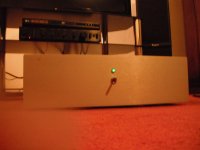
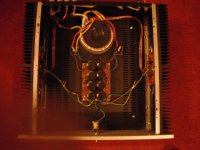
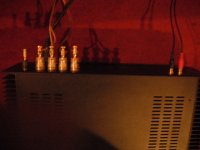
I did under bias but only slightly, i expect its atleast 90% of full bias
It lives at my friends house at the moment but will get it back one day.
Lucky he has Rogers speakers! and audiolab pre-amp which he says sounds nice with it



Last edited:
...........and audiolab pre-amp which he says sounds nice with it ]
You are reading my mind. I was just pondering adding one of a couple preamps I have to the new F5. So far I've just used the S/PDIF feed from a computer through a DAC. Are there any precautions, limitations or special considerations for pres with this design ?
Hi bcmbob, someone here should be able to answer that!
I did make a Zen v4 before this and i think it sounded wonderful, i think a made a couple of errors with it tho and it blew up 3 times over few years so on the 3rd fry up i gave up, i presume it was oscillating, what do you guys recon ?
1: Power supply Transformer and caps were in a separate box with 3 pin power lead about a meter long to the amp.
2: leads to mosfets from the board were 4-6" long (probably the worst offender) and if i moved the wires in certain positions hum/noise would come thru the speakers.
3: I built it on Prototyping board although i doubt that's the error as i probably checked my wiring million times.
But to sum up and compare Zen4 to F5 well hmm id have to hear both on the same setup. but its a close one for sure.
I did make a Zen v4 before this and i think it sounded wonderful, i think a made a couple of errors with it tho and it blew up 3 times over few years so on the 3rd fry up i gave up, i presume it was oscillating, what do you guys recon ?
1: Power supply Transformer and caps were in a separate box with 3 pin power lead about a meter long to the amp.
2: leads to mosfets from the board were 4-6" long (probably the worst offender) and if i moved the wires in certain positions hum/noise would come thru the speakers.
3: I built it on Prototyping board although i doubt that's the error as i probably checked my wiring million times.
But to sum up and compare Zen4 to F5 well hmm id have to hear both on the same setup. but its a close one for sure.
Last edited:
I am surprised no Member replied to this.Thanks, we have added RF filtering now in the IEC
Thanks Rade95. yes will be adding a bit more than the original PSU capacitance.
Iv'e been thinking about something, is it possible to have a variable resistor with the original feedback resistor so to be able to vary the amount of feedback of the amp ? i like this kind of idea as in theory you could instantly tell the difference. and also if you had not enough volume you could lower the feedback for an extra boost, all be it with perhaps a sonic difference+ more distortion.
I once did this to a B&O beomaster 2400 i think, was quite interesting!
RF filtering and DC blocking is on the signal input to the amplifier.
You can also fit RF filtering and DC blocking to the Power input of the amplifier.
These two locations are quite different and require different solutions.
Varying the amplifier gain by changing the feedback also changes the stability margins.
Generally increasing the gain decreases the feedback and this leads to an increase in the stability margins.
Going in the opposite direction and trying to reduce the gain is what can end up with a blown amplifier.
I suspect Pass determined the lowest gain the F5 could be used at, without needing separate compensation components when built using his recommendations.
Increasing the stability margins by increasing the gain can lead to a "flat" sounding amplifier. But since this is a PASS design I suspect there are a range of acceptable gain settings that all sound good.
- Home
- Amplifiers
- Pass Labs
- F5 power amplifier
